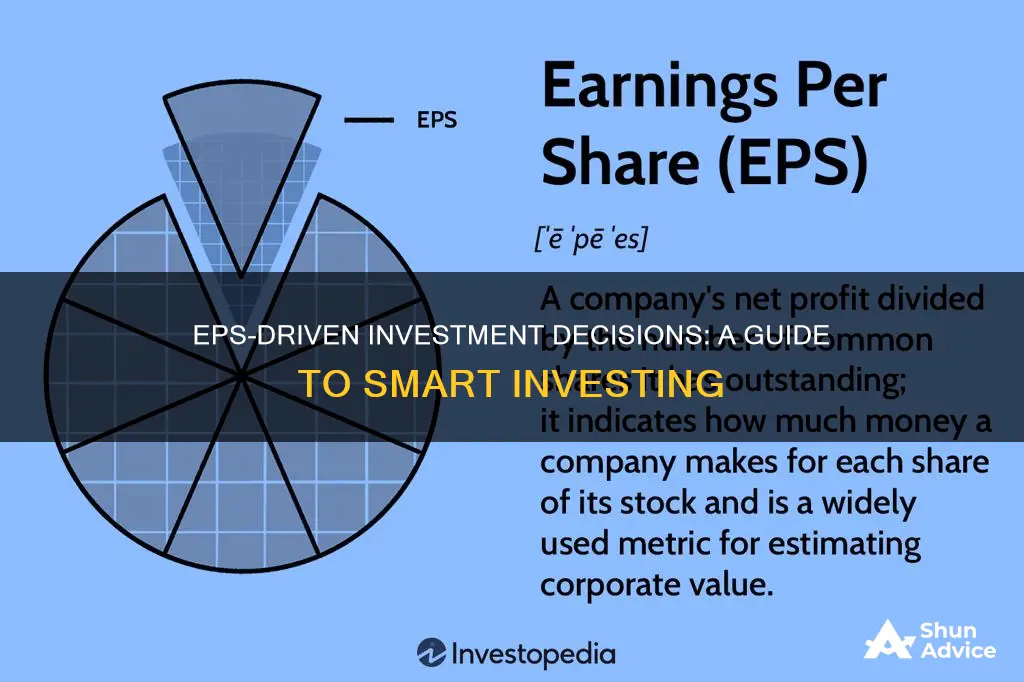
Earnings per share (EPS) is a vital metric for investors, providing a direct insight into a company's profitability. It is calculated by dividing a company's net income by the total number of outstanding shares. EPS is a key component of the price-to-earnings (P/E) ratio, which is used to determine if a company is reasonably valued.
EPS is a critical factor in determining a company's stock price and its potential value. A higher EPS indicates greater value, as investors will pay more for a company's shares if they perceive higher profits relative to its share price.
Analysing EPS over time helps assess a company's overall performance and predict its stability and growth. It is a vital tool for investors to compare the profitability of companies and make informed investment decisions.
However, investors should also consider other financial indicators alongside EPS to gain a comprehensive understanding of a company's financial health.
| Characteristics | Values |
|---|---|
| Purpose | To assess a company's profitability and compare it with its competitors |
| Formula | Net Income / Total Shares Outstanding |
| Comparative Tool | Can be used to compare companies within the same industry |
| Informed Decisions | Provides insights into a company's financial health, helping investors make informed decisions |
| Future Earning Potential | Helps investors identify potential investments |
| Stability | Helps assess the stability and reliability of a company's stock |
| Stock Price | A critical factor in determining a company's stock price |
| Limitations | EPS doesn't account for a company's assets and liabilities |
What You'll Learn

Compare EPS with industry average and competitors
Comparing a company's earnings per share (EPS) with its industry average and competitors is crucial for investors to gain a comprehensive understanding of its financial performance and make informed investment decisions. Here are the key points to consider when comparing EPS across industries and competitors:
Industry Comparison:
Comparing a company's EPS to the industry average is a useful benchmark for assessing its performance relative to its peers. Industries differ in profitability potential, market dynamics, and growth prospects. Technology companies, for instance, tend to have higher EPS due to their innovative products and high growth rates, while utility companies may have lower EPS due to their stable and regulated nature. By making this comparison, investors can determine whether a company is outperforming or underperforming within its sector.
Competitor Comparison:
In addition to industry comparison, analysing a company's EPS relative to its direct competitors is crucial for understanding its market position. Competitors within the same industry often face similar market conditions, customer preferences, and regulatory challenges. By comparing EPS figures, investors can identify companies that are outperforming their peers and gaining market share. A company that consistently has a higher EPS than its competitors may indicate superior operational efficiency, better cost management, or a competitive advantage.
Growth Rate Comparison:
The EPS growth rate is another vital aspect to consider. A high EPS growth rate indicates that a company is increasing its profitability at a faster pace, suggesting strong performance and potential future returns. Conversely, a declining EPS growth rate may signal challenges or market saturation. By comparing growth rates, investors can identify companies with positive earnings momentum and assess their growth potential.
Quality of Earnings:
While EPS provides insight into a company's profitability, it is important to evaluate the quality of those earnings. Investors should analyse the components that contribute to EPS, such as revenue sources, cost structures, and accounting practices. A company with a high EPS driven primarily by one-time gains or accounting adjustments may not have sustainable profitability. In contrast, a company generating consistent and recurring earnings is likely to have a more reliable EPS figure. By considering the quality of earnings, investors can make more informed decisions when comparing across industries and competitors.
Historical EPS Comparison:
Analysing a company's EPS over different time periods can help identify trends and patterns in earnings growth or decline. A company that consistently shows an increasing EPS over several years indicates positive financial performance.
Impact of Dilution:
EPS analysis should consider the impact of dilution, especially when companies issue additional shares or stock options. Dilution increases the number of shares outstanding, reducing the earnings allocated to each share.
EPS Growth Rate:
Calculating the EPS growth rate provides insights into a company's earnings trajectory. By comparing growth rates, investors can identify companies with higher potential for future earnings growth.
Other Profitability Ratios:
In addition to EPS, investors should analyse other profitability ratios to gain a comprehensive understanding of a company's financial health. Ratios such as Return on Equity (ROE), Return on Assets (ROA), and gross profit margin can provide insights into a company's ability to generate profits and efficiently utilise its resources.
Comparative Analysis:
Conducting a comparative analysis of companies within the same industry can provide valuable insights. By comparing EPS, along with other financial metrics such as the P/E ratio, ROE, and profit margins, investors can gain a comprehensive understanding of a company's financial health and performance relative to its peers.
How Investments Move the Needle on Owner's Equity
You may want to see also

Assess EPS growth rate and earnings quality
When assessing EPS growth rate and earnings quality, it's important to remember that EPS is a vital metric for investors to assess a company's profitability and compare it with its competitors. Here are some key considerations:
- Understanding EPS Growth Rate: The EPS growth rate measures the rate of change in a company's net profitability on a per-share basis. It is calculated as the percentage change between the ending and beginning EPS. This metric helps investors analyse a company's historical profitability and forecast its future performance.
- Evaluating Earnings Quality: The quality of EPS can be evaluated by considering the following:
- Income Statement: Analysing direct and indirect costs, EBIT, net income, and margins (gross, operating, and net) can provide insights into a company's expense management and efficiency.
- Comparisons: Comparing EPS across different periods, with competitors, and industry trends can help identify unusual spikes or growth rates.
- Cash Flow Statement: Analysing operating cash flow and operating cash flow per share relative to EPS can indicate the realisation of revenue and the impact of depreciation or amortisation.
- Trends: Monitoring EPS trends can help identify the impact of macro variables, new strategic investments, or idiosyncratic factors on a company's performance.
- Other Considerations:
- Basic vs Diluted EPS: Basic EPS calculates net income divided by outstanding shares, while diluted EPS includes the potential impact of stock options and convertible securities, providing a more conservative estimate.
- Adjustments: Non-GAAP adjustments to the EPS calculation may be necessary to exclude extraordinary items or discontinued operations.
- Revenue Recognition: Companies may have different earnings recognition strategies depending on their industry and specific circumstances.
- Share Management: Issuing new shares or repurchasing shares can impact the number of outstanding shares, affecting EPS.
A Guide to Investing in European Equities
You may want to see also

Consider dividend policy and payout ratio
When making investment decisions, it is important to consider a company's dividend policy and payout ratio. The dividend payout ratio is the total amount of dividends that a company pays out to its shareholders as a percentage of its net income. It is calculated as:
> Dividend Payout Ratio = Dividends / Net Income
A high dividend payout ratio could indicate that a company is facing financial challenges or is not focused on growth. On the other hand, a low dividend payout ratio could mean that a company is reinvesting in its business and has more potential for long-term growth.
For example, new companies that are looking to grow and expand are more likely to retain a higher percentage of their net income and reinvest it back into the company, resulting in a low dividend payout ratio. Conversely, more mature companies tend to distribute a higher percentage of their income to shareholders, leading to a higher dividend payout ratio but potentially lower growth prospects.
The dividend payout ratio is a useful metric for investors as it helps assess the sustainability of a company's dividend payments. A payout ratio over 100% indicates that a company is paying out more in dividends than it is earning, which is usually unsustainable and may lead to a dividend cut.
It is also important to analyse how a company's dividend payout ratio has changed over time. Steady, long-term growth in the dividend payout ratio can indicate sustainable growth and responsible financial management, while drastic swings may signal an unreliable dividend payment program.
In addition to the dividend payout ratio, investors should also consider other financial metrics such as dividend yield, earnings per share, and cash flow when evaluating investment opportunities.
Private Equity Interests in Levi Strauss: Who's Investing?
You may want to see also

Evaluate valuation ratios and intrinsic value
When evaluating the intrinsic value of a company, investors need to look beyond the market price to determine its true worth. This is done by analysing the company's underlying business characteristics and fundamentals rather than market sentiment or speculation.
One of the most commonly used metrics for evaluating a company's intrinsic value is the price-to-earnings (P/E) ratio. This ratio is calculated by dividing the price of a stock per share by its earnings per share (EPS) over a given period. A higher P/E ratio indicates that the stock is overvalued, while a lower P/E ratio suggests that it is undervalued. However, it's important to also consider the industry and the company's growth prospects when interpreting the results. For example, a company in a high-growth industry may have a higher P/E ratio than a company in a mature industry.
Other valuation metrics that can be used alongside the P/E ratio include the price-to-sales (P/S) ratio, the price-to-book (P/B) ratio, and the enterprise value-to-EBITDA (EV/EBITDA) ratio. The P/S ratio compares a company's market capitalization to its revenue and is useful for companies that are not yet profitable or have inconsistent earnings. The P/B ratio compares a company's market capitalization to its book value (assets minus liabilities) and is useful for companies with a lot of tangible assets, such as manufacturing or real estate companies. The EV/EBITDA ratio compares a company's enterprise value (market capitalization plus debt minus cash) to its earnings before interest, taxes, depreciation, and amortization, and is useful for companies with high levels of debt or those in capital-intensive industries.
Additionally, investors can use several models to calculate a company's intrinsic value, including dividend discount models, discounted cash flow analysis, and residual income approaches. These models consider factors such as free cash flow, earnings, and the cost of capital to determine a company's intrinsic value.
By comparing a company's calculated intrinsic value with its market price, investors can make more informed investment decisions and identify undervalued or overvalued stocks.
Public Equity Investment: How to Invest in Stocks
You may want to see also

Compare EPS with share price
Earnings per share (EPS) is a vital financial metric for investors as it provides a direct insight into a company's profitability. It is calculated by dividing a company's net income by the total number of outstanding shares. The higher the EPS, the more profitable a company is perceived to be, making its stock more attractive to investors.
However, EPS should not be used in isolation when evaluating a company's financial health. It is important to consider other financial indicators alongside EPS, such as the price-to-earnings (P/E) ratio, debt-to-equity (D/E) ratio, and return on equity (ROE).
Comparing EPS with the share price of the stock helps determine the value of earnings and how investors feel about future growth. A higher EPS indicates greater value as investors will pay more for a company's shares if they believe the company has higher profits relative to its share price.
Additionally, EPS can be used to compare the profitability of different companies, facilitating better-informed decisions regarding portfolio diversification. It is a useful tool for analysts as it enables them to compare companies within the same sector.
While EPS is a valuable metric, it has some limitations. It does not reflect a company's cash flow, debt obligations, or overall financial health. It can also be manipulated by companies through share buybacks or changes in accounting policies. Therefore, it is crucial to consider other financial metrics and factors when making investment decisions.
How Much Cash Should You Hold in Your Investment Portfolio?
You may want to see also
Frequently asked questions
EPS stands for Earnings Per Share. It is a vital financial metric that provides investors with a direct insight into a company's profitability. EPS is calculated by dividing a company's net income by the number of outstanding shares. The higher the EPS, the more profitable a company is perceived to be, making its stock more attractive to investors.
The basic formula for calculating EPS is: Net Income / Number of Outstanding Shares. However, it's important to note that there are also diluted EPS calculations, which take into account potential increases in shares due to options, warrants, or convertible securities.
Factors that can influence EPS include a company's net income, the number of outstanding shares, dividends, potential share dilution, capital expenditures, and economic and industry trends.
EPS can be used to compare the profitability and value of companies within the same industry or sector. By comparing the EPS of different companies, investors can identify which companies are more profitable and efficient.
While EPS is an important metric, it should not be the only factor considered when making investment decisions. Investors should also look at other financial ratios such as the Price/Earnings (P/E) ratio, Debt/Equity (D/E) ratio, and Return on Equity (ROE). Additionally, it's important to analyze the company's financial health by reviewing financial statements, growth prospects, management quality, industry trends, and risk factors.







